Oxyhaemoglobin Study guides, Revision notes & Summaries
Looking for the best study guides, study notes and summaries about Oxyhaemoglobin? On this page you'll find 28 study documents about Oxyhaemoglobin.
Page 2 out of 28 results
Sort by
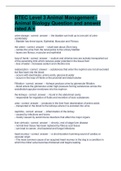
-
BTEC Level 3 Animal Management - Animal Biology Question and answer rated A +
- Exam (elaborations) • 12 pages • 2023
- Available in package deal
-
- £13.34
- + learn more
BTEC Level 3 Animal Management - Animal Biology Question and answer rated A +urine storage - the bladder can hold up to one pint of urine comfortably - Bladder has three layers. Epithelial, Muscular and Fibrous the ureter - small tube about 25cm long - carries the urine from the renal pelvis to the urinary bladder - layers are fibrous, muscular and epithelial loop of henle - sodium and chlorine ions are actively transported out of the ascending limb which reduces water potent...
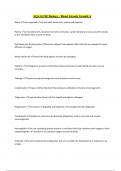
-
AQA GCSE Biology – Blood Already Graded A
- Exam (elaborations) • 2 pages • 2024
- Available in package deal
-
- £8.89
- + learn more
AQA GCSE Biology – Blood Already Graded A Blood Fluid composed of red and white blood cells, plasma and platelets Plasma Carries blood cells, dissolved nutrients, hormones, carbon dioxide and urea around the body. It also distributes heat around the body. Red blood cells (Erythrocytes) Biconcave shaped, haemoglobin filled cells that are adapted for quick diffusion of oxygen. White blood cells Protect the body against invasion by pathogens Platelets Cell fragments present in blood...
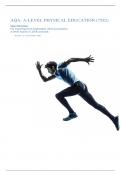
-
AQA: A-LEVEL PHYSICAL EDUCATION (7582) Specification For teaching from September 2016 onwards for A-level exams in 2018 onwards Version 1.5 15 November 2021
- Summary • 128 pages • 2023
-
- £12.13
- + learn more
Contents 1 Introduction 5 1.1 Why choose AQA for A-level Physical Education 5 1.2 Support and resources to help you teach 5 2 Specification at a glance 7 2.1 Subject content 7 2.2 Assessments 7 3 Subject content 9 3.1 Factors affecting participation in physical activity and sport 9 3.2 Factors affecting optimal performance in physical activity and sport 18 4 Scheme of assessment 31 4.1 Aims 31 4.2 Assessment objectives 31 4.3 Assessment weightings 32 4.4 Synoptic assessment 33...
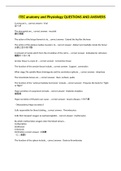
-
ITEC anatomy and Physiology QUESTIONS AND ANSWERS
- Exam (elaborations) • 2 pages • 2023
-
- £6.87
- + learn more
A verrucae is... correct answer: Viral 足イボ The pterygoids are... correct answer: musclek 顔の側面 The action of the biceps femoris is to... correct answer: Extend the hip,flex the knee The action of the gluteus medius muscle is to... correct answer: Abduct and medially rotate the femur お尻と足の付け根 A network of canals which from the circulation of the cell is.... correct answer: Endoplasmic reticulum 細胞のくねくね Areolar tissue is a type of...
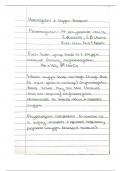
-
Oxygen transport, haemoglobin and BOHR effect
- Summary • 6 pages • 2023
-
- £5.09
- 1x sold
- + learn more
A summary of haemoglobin, oxygen transport and the BOHR effect as seen on the CCEA spec for AS Biology in Northern Ireland. This is a document showing the most important pieces of information which are crucial when trying to understand this module.
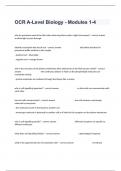
-
OCR A-Level Biology - Modules 1-4 Actual Questions And Well Elaborated Answers.
- Exam (elaborations) • 17 pages • 2024
- Available in package deal
-
- £10.92
- + learn more
why do specimens need to be thin when observing them under a light microscope? - correct answer to allow light to pass through identify and explain the starch test - correct answer add iodine dissolved in potassium iodide solution to the sample - positive test = blue-black - negative test = orange-brown why is the structure of the plasma membrane often referred to as the fluid mosaic model? - correct answer ...
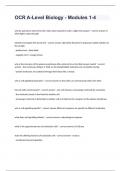
-
OCR A-Level Biology - Modules 1-4 Exam Solution.
- Exam (elaborations) • 17 pages • 2024
- Available in package deal
-
- £10.51
- + learn more
why do specimens need to be thin when observing them under a light microscope? - correct answer to allow light to pass through identify and explain the starch test - correct answer add iodine dissolved in potassium iodide solution to the sample - positive test = blue-black - negative test = orange-brown why is the structure of the plasma membrane often referred to as the fluid mosaic model? - correct answer - the continuous bilayer is 'fluid' as the phospholipid molecules are constantl...
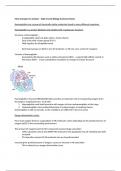
-
Summary Notes on Mass Transport in Animals - AQA A Level Biology
- Summary • 9 pages • 2023
-
- £8.99
- + learn more
Summary Notes on Mass Transport in Animals - AQA A Level Biology A* and A quality Detailed notes with diagrams Tailored vocabulary towards mark schemes with key marking points bulleted AQA specific - mark schemes used to make notes specific
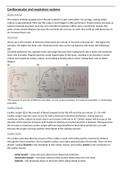

-
Cardiovascular and respiratory systems
- Summary • 6 pages • 2023
-
- £6.49
- + learn more
SV, HR, CO, Cardiac Cycle, Cardiac conduction system, regulation of heart rate, venous return, redistribution of blood flow, mechanics of breathing, Gas transport, Gaseous exchange, Oxyhaemoglobin dissociation curve, impact if physical activity.
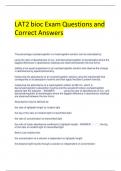
-
LAT2 bioc Exam Questions and Correct Answers
- Exam (elaborations) • 10 pages • 2024
- Available in package deal
-
- £10.92
- + learn more
LAT2 bioc Exam Questions and Correct Answers The percentage oxyhaemoglobin in a haemoglobin solution can be calculated by: using the ratio of absorbances of oxy- and deoxyhaemoglobin at wavelengths where the biggest difference in absorbance readings are observed between the two forms. adding a live yeast suspension to an oxyhaemoglobin solution and observe the change in absorbance by spectrophotometry. measuring the absorbance of an oxyhaemoglobin solution using the wavelength that c...

How did he do that? By selling his revision notes on Stuvia. Try it yourself! Discover all about earning on Stuvia


